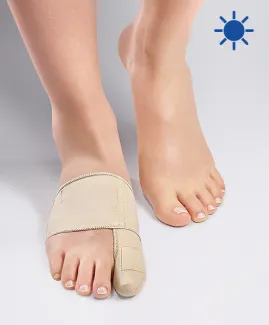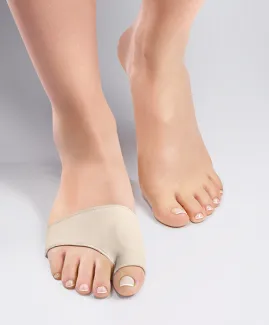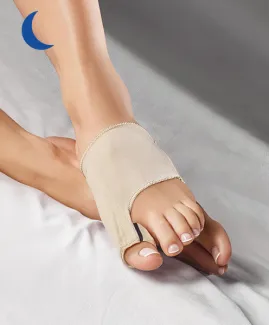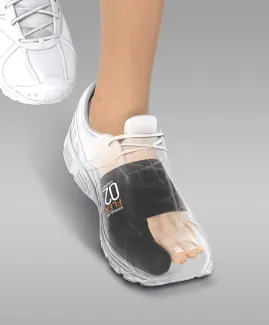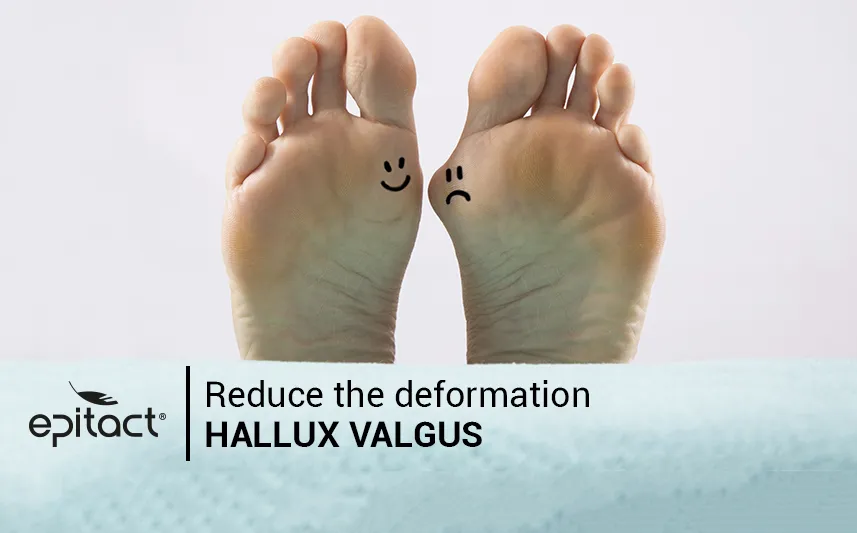
Hallux Valgus also known as 'bunion'
Hallux valgus, or bunion, refers to the deviation of the big toe towards the other toes. The end of the 1st metatarsal is moving aside and is becoming prominent: the internal exostosis (the bunion) is forming. This deformity affects 5 to 10% of the population and can be very disabling.
Who is more specifically affected by this deformity?
Studies conducted on this foot condition have shown that there is:
- a congenital predisposition (in 1/3 of the cases): the deformity and the bunion appear before the age of 15;
- a predisposition depending on the gender: women are 9 times more affected than men;
- a predisposition in Egyptian foot where the first toe is longer than the other and it tends to move towards the 2nd toe;
- a predisposition in people who wear narrow and pointy shoes. A study conducted in Africa confirms that wearing shoes do lead to the formation of a hallux valgus.
How does hallux valgus evolve?
At first, the pain occurs when putting on the shoes or after a walk: it’s a simple inflammation combined with a bursitis (fluid-filled sac) that can turn septic. The foot deformity keeps evolving with really painful episodes punctuated by slack periods. Consequences can be felt on all the foot area:
- Metatarsalgia: the deviation of the big toe leads to a modification of supports: the big toe doesn’t play its support role anymore and the charge is transferred to the second and third metatarsus.
- Toes turn into claw toes to increase the grip.
- Corns appear between the toes that are overlapping or on the back of the claw toes
However, hallux valgus is a deformity than cannot disappear over time.
What are the solutions to relieve pains related to a hallux valgus?
Above all, it is essential to wear suited shoes to avoid too much pressures and frictions on the bunion: that means no pointy and narrow shoes.
If the pains are recurrent or constant, the bunion protector* is a noticeable solution.
Hallux valgus is often associated with plantar pains (calluses under the 2nd and 3rd metatarsus), the protection cushions* are then the suitable device.
All these products provide undeniable relief but on the other hand, they are not designed to correct hallux valgus.
If these pains are really unbearable and the deformities are too significant, surgical procedure must be considered.
What solutions to correct the deformity of the hallux valgus?
- During the day, the daily wearing of the bunion straightener with EPITHELIUM FLEX™* has been designed to correct and limit the progression of hallux valgus while soothing joint pains.
- Thanks to its thin and flexible patented design which incorporates the EPITHELIUM FLEX™, the corrective bunion support can be worn in all closed footwear. Unlike rigid bunion splints, it has an effect while walking on factors that may aggravate the deformity.
- Contraindications: the bunion brace must not be used if the great toe does not move laterally.
- The external patented EPITHELIUM FLEX™ tendon realigns the great toe. The level of correction is adjustable by exerting a more or less intense tension on the tendon.
- The external patented EPITHELIUM FLEX™ tendon is dedicated to absorb the pressure put on the bunion and so to soothe the pains.
- The EPITHELIUM™ spot creates a comfortable counter-support stop with the shoes and allows to push back the 1st metatarsal.
- The extra-thin metatarsal compression strap aims to limit the squeezing and expansion of the forefoot.
- During the night, wearing the rigid bunion protector* will soothe the nocturnal joint pains and protect the bunion from contact with sheets, mattress…
*These products are class I medical devices that bear the CE marking under this regulation. Carefully read the instructions before use. Manufacturer: Millet Innovation. 03/2020
 Pharmacie
Pharmacie